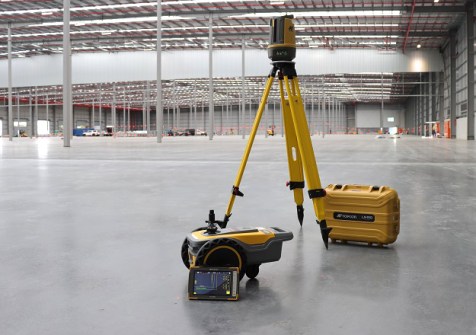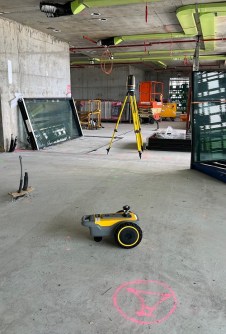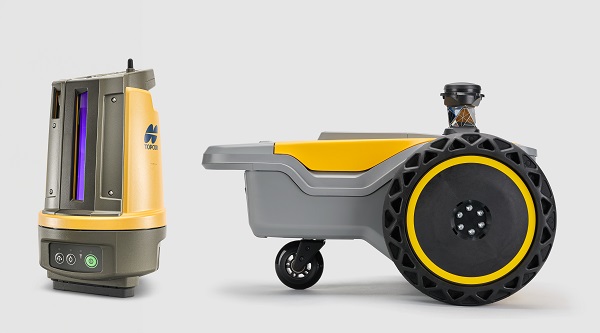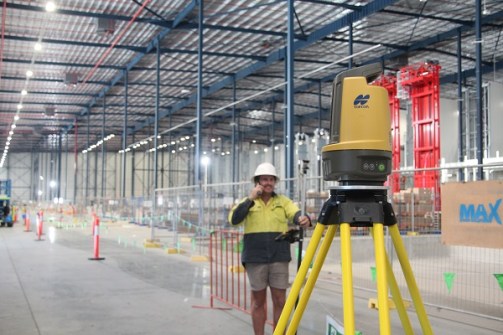
HP SitePrint from Aptella automatically prints plans directly onto the construction surface, removing the need for manual methods and increasing speed and accuracy.
PARTNER FEATURE
Advancements in robotics and automation are enabling faster, more accurate set-out and as-built verifications for the construction sector. Dubbed ‘digital construction,’ an oxymoron for an industry that is physical in every sense, these new methods could contribute to a shift in labour-productivity growth that for decades has stagnated around 1%1.
“Infusing digital technology” and “advanced automation”2 are recommended measures included in seven key areas, that range from reshaping regulation and contractual frameworks to reskilling the workforce. Technology would arguably underpin each of the seven, as it does with most aspects of our lives where modern techniques help us to analyse, streamline and automate information to improve processes and communication.
Every building project begins life in the digital landscape, with computer-aided design (CAD) models created by a combination of architects, engineers and surveyors. Once approved and boundary alignments verified, surveyors are engaged to mark out control points, and where required, perform set-out for key features such as grid lines. With expertise in managing CAD models, surveyors continue to marry the digital with the physical by using optical total stations and field-based CAD software to precisely mark out plans on site.
Outside of surveyor-led set-out, layout of these computer-based plans on the building site is typically where digital technology meets an abrupt end, often with expensive consequences. Most of the set-out falls to the building trades, who calculate offsets and scale measurements based off printed, paper plans using measuring tapes, stringlines, and various shades of spray paint.

“The potential for human error is unavoidable when you are relying on these manual methods,” says Mitch Laughlin, who specialises in building automation technology at Aptella.
“Even the most experienced, skilled people can make a mistake during the set-out process, that may not be picked up until a lot further into the job, such as when a surveyor or engineer comes back to check as-builts. Then you have the cost and time delays to fix it, which leads to budget and program blow-outs,” he added.
Enabling the building trades with the skills and tools to perform set-out tasks and check their work as they go, is ticking several boxes when it comes to transforming productivity and reducing rework, Mitch explains. And far from replacing the work typically done by a surveyor, these methods require the combined expertise of multiple stakeholders who are all working to the same, digital plans.
“It benefits all parties if the work being done can be checked along the way to make sure it’s right, but with the skills shortage of surveyors it’s not possible, affordable, or in most cases desirable, for them to do so,” he says. “A surveyor is of course pivotal for establishing control on site and any boundary verifications, but with these new methods the building trades can then learn how to perform a resection and set-out everything from footings, walls, columns, penetrations and more without reliance on the survey crew.”
Mitch notes that having more eyes looking at the same project data helps identify any errors before they escalate into bigger problems. “We’ve had instances where customers have identified incorrect control points on the job, because when they go to set-out using the digital plan nothing aligns to it. The more different trades get to work with the data and digital layout methods, the better the outcomes for everyone involved.”
A CAD design is extremely complex with many layers of data, so another example Mitch says works well with Aptella’s customers is for surveyors to provide a simplified data file for the contractors for each stage of the build and their specific work on the job.
“The plumber gets the design for drainage, penetrations and services, whereas the builder may get the footings, slab and columns, so both parties can work with the data they need and continually check and verify their work with a digital record of what has been done,” he adds.

Aptella provides comprehensive training and remote technical support for customers in the building trades that are adopting these new methods. “There is a direct correlation between how committed our customers are to upskilling their workers and the speed at which they see productivity gains,” Mitch says. “Ensuring their team is confident in how to use it, with our Tokara remote access platform to guide them over the phone when they get stuck, means they quickly reap the benefits.”
New advancements in robotics promise to offer even greater productivity gains. Robots such as HP SitePrint can automatically print construction plans directly onto the construction surface, removing the need for manual methods and increasing speed and accuracy.
“HP SitePrint sets out a complete design, including lines, arcs, points, text references, and in an array of colours to bring the plan to life on site without any further calculations or measurements needed,” Mitch says.
The fine lines and text references leave no room for misinterpretation by the various contractors working on site, with millimetre-level accuracy of every point on the plan. Unlike traditional methods that require multiple people and result in set-out with little to no reference information shown, the robot gives a precise mark and legible reference that’s easy for everyone on site to understand and follow. “The enriched information provided by the HP SitePrint is unmatched,” he adds.

Systems such as Topcon’s LN-150, which is paired with a field controller and software, provides a fully robotic, one-person total station that integrates seamlessly with the HP SitePrint robot.
“The LN-150 is hugely popular for construction set-out because it has the accuracy of a fully robotic total station but without the complexity of a premium optical instrument that is usually over-specified for these applications,” Mitch says.
“Surveyors can use their high-end instruments for cadastral work and run the LN-150 with the HP robot as a robust, accurate solution to set-out construction jobs at scale.”
For a demonstration please visit aptella.com or call 1300 867 266.
Footnotes:
1. ‘Reinventing Construction: A Route to Higher Productivity,’ McKinsey & Company, 2017. p.11






